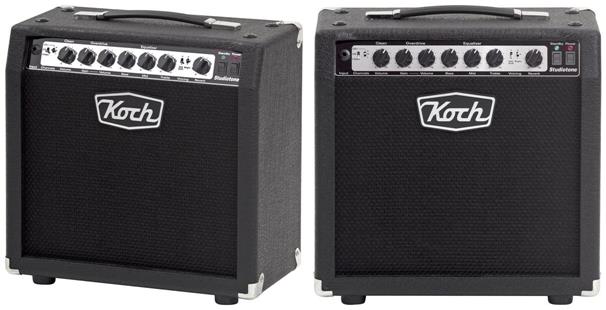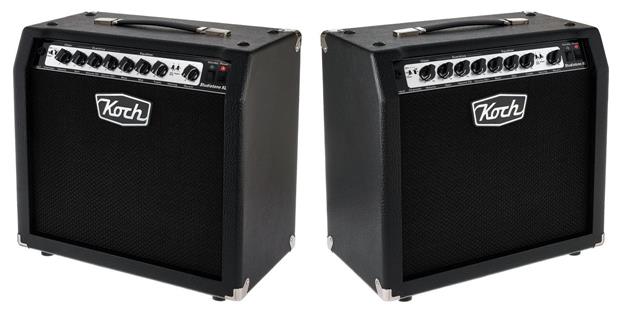The Best Guitar Amplifiers of the KOCH brand
Let’s go with a selection of the most valued guitar amplifiers for this brand. This is a selection based on different parameters such as quality, sales leader and positive reviews.
Amplifier Koch Amps Studiotone 20 Combo
Contenidos de la página
This amplifier usually has a price around 839.00 €
- Power: 20W
- Equipped with: 1x 12″ VG12-60 Koch loudspeaker
- 3 Channels: Clean, overdrive, overdrive boost
- Class A
- Tubes: 2x EL 84
- Passive bass – mid – treble equalizers
- 2 Vocing switches: Mid shift (2-way), bright (3-way)
- Separate loudspeaker outputs: 4, 8, 16 ohm
- Speaker on/ off switch
- Recording output
- Effect loop
- Reverb
- Headphone output
- Dimensions: 45 x 24 x 44 cm
- Weight: 17.5 kg
- Incl. FS2-ST foot switch

Now that we have seen the features of this amplifier Koch Amps Studiotone 20 Combo watch this related video to learn more.
And you have the following options to buy the amplifier Koch Amps Studiotone 20 Combo.
And if you want to know more about this model you can find here the review of this amplifier Koch Amps Studiotone 20 Combo.
Amplifier Koch Amps Jupiter JUP45-C
This amplifier usually has a price around 538.00 €
- Power: 45 W
- Equipped with: 1x 12″ Koch VG12-60 speaker
- 2x 12AX7 tubes in the preamp and power amp
- 3 Switchable channels: Clean, Overdrive, High Gain
- 3-Band EQ with contour switch
- Buffered effects loop
- Spring type reverb
- ATR Technology
- Output with loudspeaker emulation and passive filter
- Weight: 19.1 kg
- Dimensions (W x D x H): 540 x 260 x 460 mm
- Includes 2-way footswitch

Now that we have seen the features of this amplifier Koch Amps Jupiter JUP45-C watch this related video to learn more.
Some comments from people who come to the forum about this model:
Comment:
Use
Home(studio), band practice, gigs.
Pros
*Very nice clean sound on the cool (clean) channel, with a lot of headroom (so, the clean sound does not break up, but stays clean). If you do want a slightly broken up/distorted sound, this can be achieved as well, by adjusting volume and gain settings or going over to the hot (OD) channel (with its own gain and volume knobs). You can switch between channels by using the left button on the foot switch (FS), or use the switch button on the back of the amp.
*So, the amp acts and sounds pretty much like a tube amp, even though it is a hybrid. That is because there is a tube in the preamp and one in the power amp (followed by MOSFETs). Less tubes should mean less maintenance and certainly less maintenance costs. With a dimmer (master volume) you can change the volume of the amp, without changing the nature of the sound you’ve dialed in with the gain, volume, 3-band EQ, contour, and (the nice sounding!) reverb. The EQ knobs and contour-switch are subtle (and shared by the two channels), but certainly noticeable. The gain-boost option is nice for soloing, or for creating a heavier sound for rhythm guitars. It seems to provide a boost in volume, but I think it actually boosts the mids instead.
*The whole amp, from the on/off switch to the housing (and also the footswitch with 5 m cable ) appears to be very sturdy (I guess that is where part of the weight comes from; the amp is some 19 kg and not 16 kg as you find in a lot of review articles).
Cons
*Both channels (cool/clean and hot/distortion) share the same EQ and reverb section. However, I favor other EQ-settings for the clean channel than I do for the distortion channel.
*The distortion channel is not that impressive (personal taste).
*Overall, the sound could use just a tad bit more body to it.
*Although not super heavy, it is still 19kg. But that comes with entering the tube-amp territory. So, can’t really count it as a comp.
Experience from the last year
I’ve had it for over a year, and so far, I am pretty happy with it. I use it for band practice, for gigs and jam-sessions. It is certainly loud enough for any of these uses. Should you need even more volume (if you have an insanely loud drummer, maybe?), you can simply mic the amp or connect an extra cabinet. You can also use the speaker emulated output if you do not want to mic the amp. I find that it gives a very good sound if you do this (and the sound guys/galls are usually pretty happy with this option, as well).
LONG STORY
I bought the Koch Jupiter 45 Combo as a replacement for the (of course much cheaper) Fender Mustang IIIv2 that I returned. The footswitch of the Fender Mustang III had horrible latency. I have read that the Blackstar TVP ID60 (also a modeling amp) has this problem, as well, making current day modeling amps probably not very suitable for on stage use when in need of (quick) mid-song setting changes. (Also, in band setting the Fender sounded sounded very thin and powerless).
So, in search for a replacement, I tried out a couple of other amps: I first A/B/C-tested a Roland Blues Cube Stage (solid state amp), a Laney CUB 12R (all tubes) and a VOX AC15C1 (all tubes). I wanted to also test the Koch Jupiter 45 (hybrid, with one 12AX7 tube in the pre-amp and one 12AX7 in the power amp, and then some MOSFETs), which was recommended to me. However, this amp/brand is hard to find in music stores.
So, I first tested the Roland, the Laney and the Vox with a Gibson SG. I dropped the Roland Blues Cube Stage based on me not liking the sound of it, compared to the other amps. Also, I think the Roland is pretty expensive for a solid state (and that is without a rather expensive footswitch). I did like the option to combine the clean and distortion channel on this amp. And it has variable power output, making it suitable for different settings (home, band practice-room, stage).
The Laney CUB 12R sounded pretty good (I liked the distortion you could dial in), but not as "wide" as the VOX. However, from what I understand, it only has one channel, so it seems that it is not possible to quickly switch between clean and distortion (or is it, somehow?). Of course you could use a distortion/OD pedal in front of it. But, I read several reviews stating that the amp might not be loud enough for even smaller gigs (it’s 15W, just like the VOX, but the latter is supposed to be very loud, if you want it to be).
The Laney has the option to turn to 1W for the "bedroom". And it has an external FX loop which the VOX does not have, and a connection for an external speaker (just like the VOX) should you want to use an additional cabinet. Both do not have a recording output, nor a headphone out.
As I said, the VOX was way more "wide" in its sound, and a lot more sparkling clear. The VOX has 2 channels with separate inputs, but no switch on the amp. You have to buy an ABY-pedal to be able to switch between the clean channel en the top boost channel. A good quality ABY switch will costs you an additional $100, at least. In reviews people talk about the VOX not having much headroom on the normal channel, so when you turn it up loud(er), the clean sound is not completely clean anymore. The VOX is almost twice as heavy as the Laney: some 22kg.
In another shop I tried out a Fender Blues Junior III, but I was not all that impressed (it seemed kind of buzzy when turned up loud in clean. And not distortion buzzy, just buzzy).
So, that left me with the Vox AC15C1 and a yet to be tested Koch Jupiter. I finally found a shop that had both the Vox and the Koch in stock so that I could A/B them (again using a Gibson SG). I had brought my earplugs, so I could turn up both amps very loud (for a short while, of course). And indeed, the Vox did not have enough headroom. It broke up pretty quickly. I want to be able to play clean also in louder (non-amp mic-ed) set-ups, so that pretty much eliminated the Vox AC15C1 from my list. (A Vox AC30 supposedly has a lot more headroom, but also is a lot more expensive and a lot heavier [>30kg]).
It left me with the Koch Jupiter 45, which I quite liked, especially the clean sound of it! The Jupiter has a ?dimmer? knob so you can play your clean and overdriven channel at the level you like. It acts and sounds like a full tube amp, if you want it to, although the sounds seems to have a bit less ?body? to it, but that might well be the sound design Koch was going for. I like that it has a FX-loop and a record/PA-out. The record/PA-out does not cut off the signal to your speaker, so you can use your amp as a stage monitor, although if you change the volume, it will have an effect on the level of the signal going to the mixing desk, as well. (B.t.w. you can cut off the signal to your speaker, without any harm done, by unplugging the speaker cable). It also has an output for an additional cabinet.
I would have liked a volume control specifically for the FX loop, but since the loop is serial, that might not be possible without influencing the master output, when the effect is turned off. I also would have liked separate EQ-controls for the clean (cool) channel and the overdriven/distortion (hot) channel. Of course, that would come with a price increase.
The footswitch (FS2) is very handy. It has a 5 meter cable attached to it. I would have liked an input jack on the FS so that you can tailor the lenght of the FS cable to your needs. Also, a three button FS would have been nice, so that you don’t have to chose between gain-boost and reverb on/off for the right hand button.
The fact that it has only two tubes in it, should make it cheaper in maintenance compared to a full tube amp.
I have tested it out in band (practice)-situation, jam-sessions and gigs and it was (way!) more than loud enough.
It takes pedals well, both those "designed" to go in between the guitar and the amp, and those that should ideally go in the FX-loop. This is nice, because the distortion is not that impressive, speaking from personal taste.
I would have given "sound" and "total" more stars if the clean channel had a bit more body to it, and if I’d been more happy about the distortion sound of the Hot-channel. Having said that, it is a real pleasure to play this amp. It makes you want to pick up your guitar and play.
Thomann’s service was again good and quick.
Comment:
I bought the Koch because it was a hybrid amp and I wanted to try to retain a Valve Amp sound whilst adding the reliability of solid state. My research told me that the pre-amp valve had excellent longevity. I had been using a Marshall JC200 DSL400 Combo which began a gig sounding perfect and totally died after half a set. No spare so rerouted through the PA …in short it was a mess !!
So the Koch arrived and I plugged in my pedalboard (SKB) and guitar (Cassidy) turned everything on and started playing.
After ten minutes I was a very happy bunny indeed.
The Amplifier sounded like a valve amp…but more importantly it was very responsive…flexible to the ‘n’th degree.
The controls enable you to extract pretty much any sound from bright clean to super crunchy. I love the gain control on the clean channel which allows you to flavour the clean to your taste. I like a hint of dark on the clean channel !! An added bonus was the effects loop which works so much better than my previous amp. I can now split my board putting the wah/compression/distortion overdrive through the front end and the other stuff into the loop…really really excellent.
I cannot praise the Koch too highly… it’s well built, good looking, and gives you such sound versatility and so far total reliability ! I originally bought it as a backup to the Marshall (Which is now repaired) but to be honest I find myself using it for every gig.
Apart from giving me the confidence of knowing it’s reliable it backs that up with a brilliant sound and you can’t ask for better than that !!
And finally a side benefit is the number of conversations I’ve had with fellow musicians who approach me after the gigs and ask me "..hey…what’s that amp? I love it!!"
And you have the following options to buy the amplifier Koch Amps Jupiter JUP45-C.
And if you want to know more about this model you can find here the review of this amplifier Koch Amps Jupiter JUP45-C.
Amplifier Koch Amps The Greg
This amplifier usually has a price around 2190.00 €
- Greg Koch Signature Model
- 3 Channels
- Power: 50W
- Equipped with: 2x 10″ Jensen Falcon C10-40 loudspeakers
- Preamp tubes: 6x 12AX7
- Power tubes: 2x EL34
- Closed-back housing construction
- Controls: Presence Master – (2 x) Drive – Volume – Bass – Middle – Treble
- Switch: Reverb> Tremolo / Tremolo> Reverb – Pentode (full power) / Triode (half power)
- Effects: Reverb – Tremolo
- Effects loop: Buffered serial or parallel with volume control
- Connections: Input (6.3 mm jack) – FX Loop Send and Return (2 x 6.3 mm jack)
- Footswitchable OTS (Output Tube Saturation) with drive and volume controls
- Footswitchable tube tremolo and reverb
- Dimensions (W x D x H): 65 x 30 x 54 cm
- Weight: 26 kg
- Incl. 5-Way footswitch

Now that we have seen the features of this amplifier Koch Amps The Greg watch this related video to learn more.
And you have the following options to buy the amplifier Koch Amps The Greg.
And if you want to know more about this model you can find here the review of this amplifier Koch Amps The Greg.
Amplifier Koch Amps Studiotone XL Combo
This amplifier usually has a price around 999.00 €
- Tubes: 4x EL 84 Class A
- Power: 40 W
- 3 Channel
- Clean – overdrive – overdrive boost; all with their own volume knob
- Passive bass – mid – treble equalizer
- 2 Vocing switches: Mid shift (2-way), bright (3-way)
- Equipped with: 1x 12″ VG12-60 Koch loudspeaker
- Separate loudspeaker outputs (4-8-16 O)
- Speaker on/ off switch
- Recording output
- Effect loop
- Reverb
- Headphone output
- Dimensions: 50 x 47 x 28 cm
- Weight: approx. 20 kg
- Incl. FS2-ST foot switch

Now that we have seen the features of this amplifier Koch Amps Studiotone XL Combo watch this related video to learn more.
Some comments from people who come to the forum about this model:
Comment:
Watch out for the small dummy load toggle switch on the back when carrying it. It can be quite panic inducing at a sound check if the switch has been accidentally moved to dummy load – it cuts out the speaker sound.
Comment:
And you have the following options to buy the amplifier Koch Amps Studiotone XL Combo.
And if you want to know more about this model you can find here the review of this amplifier Koch Amps Studiotone XL Combo.
Other posts you may be interesting in

